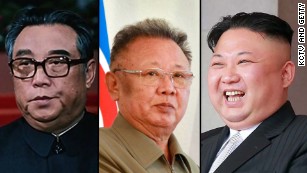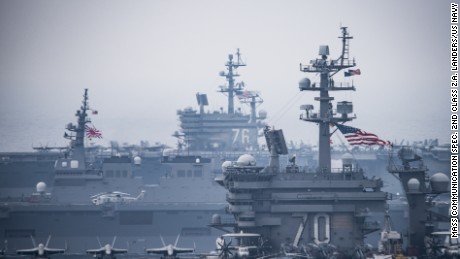As US military flexes, North Korea marches toward nuclear capability
At this point, the pattern is familiar.
One week, North Korea fires off a ballistic missile, then US B-1 bombers stretch their wings over South Korea. The next, North Korean leader Kim Jong Un oversees another missile test, and two US Navy aircraft carriers show their might in waters off the Korean Peninsula.
This merry-go-round of military flexing in the Pacific has become the norm.
But as the US stacks more and more firepower in North Korea's backyard, Pyongyang marches closer to nuclear capability -- and analysts say there is little the world's strongest military can do about it.
And with most estimates putting Kim's unpredictable regime three to five years away from achieving its nuclear ambitions, the US is simply running out of time.

"There is no amount of military pressure alone that will compel Kim Jong Un to volunteer to eliminate his nuclear and missile programs," said Adam Mount, a senior fellow at the Center for American Progress.
After two decades of sticking largely to the same ineffective playbook, the course is unlikely to change without a drastic shift in policy from an outside nation.
"The likely outcome will be similar to prior efforts," predicted Robert Ross, a Boston College professor and China policy expert. "North Korea will call our bluff, the US will draw back from using military force, and North Korea will continue to develop their nuclear program."
China's President Xi Jinping calls for a "peaceful" resolution to tensions on the Korean Peninsula during a phone call with President Donald Trump as the USS Carl Vinson aircraft carrier strike group churned toward the contested region. Trump, eager to stop rapid advances in North Korea's nuclear and ballistic missile programs, signals a break with decades of US policy as he looks to coax China into ramping up the pressure on North Korea.
Trump says he was sending "an armada" to Korean waters potentially to deal with threats from North Korea. The statement came after Pyongyang said it had successfully launched a new ballistic missile.
North Korean monitoring service 38 North says the country's Punggye-ri nuclear site is "primed and ready" for a sixth nuclear test.
North Korea celebrates the Day of the Sun, an annual event commemorating the birth of the country's founder Kim Il Sung. Many observers expected a nuclear test or missile launch in honor of the occasion, but in the end, nothing happened on that day.
Trump tweets about China help with N Korea — Trump sent tweets this week praising Xi for committing to help restrain North Korea, which may be on the verge of a sixth nuclear test. Beijing is Pyongyang's closest ally.
Trump tweeted that he'd told Xi a trade deal with the US would be "far better for them if they solve the North Korea problem." On Wednesday, Trump tweeted that he and Xi had had "a very good call" about Pyongyang. And Thursday, the president tweeted that he had "great confidence that China will properly deal with North Korea. If they are unable to do so, the U.S., with its allies, will! U.S.A."
North Korea conducts a failed missile launch, the day after the Day of the Sun, the country's most important holiday. The first missile test after US President Donald Trump's inauguration came when he was meeting with Japanese Prime Minister Shinzo Abe in February.
US bombers fly near Australia. Two B-1 bombers also flew over South Korea in late April, according to a US defense official.
US and South Korea conduct 'Max Thunder' joint military drills.
The USS Michigan — a guided-missile submarine — arrived in South Korea for what a US defense official described as a show of force amid tensions between the US and North Korea.
North Korea threatens to sink an American aircraft carrier that is beginning joint drills with two Japanese destroyers in the western Pacific Ocean. The USS Carl Vinson was joined by the Ashigara and Samidare destroyers in "tactical training" drills near the Philippines.
North Korea stages its largest ever military drillto mark the founding of the country's army, amid rising tensions with the West.
Two US B-1 bombers departed Andersen Air Force base in Guam and conducted a joint drill with South Korea and Japan's air forces over the Korean Peninsula, according to the US Air Force. This is the fourth US presence mission in the Indo-Asia-Pacific region since April 1 and bombers have flown near the Korean Peninsula twice in the past two weeks — a move that has drawn sharp criticism from North Korea amid rising tensions in the region.
North Korea fired what analysts called its most successful test ever in its quest to develop ballistic missiles that can carry nuclear warheads. That test came as China was hosting a major economic summit in Beijing. In early April, Pyongyang tested a missile as Trump and Chinese President Xi Jinping prepared to meet at a summit in Florida.
The Navy aircraft carrier USS Ronald Reagan conducted training off the coast of Japan and was expected in the coming days to join the USS Carl Vinson in the region, putting two carriers in the vicinity of the Korean Peninsula, two US officials tell CNN.
Pyongyang sends a medium-range ballistic missile into the waters off its east coast. North Korea said that projectile was a ground-to-ground strategic ballistic missile Pukguksong-2, state news agency KCNA reported.
North Korea launches a ballistic missile test, its third in less than three weeks. The short-range ballistic missile traveled an estimated 248 miles, splashing down within Japan's exclusive economic zone, an area of sea where commercial ships are known to operate, according to statements from both the Japanese government and the South Korean military.
Two US Navy aircraft carriers are expected to begin training together as soon as Wednesday in the Sea of Japan, for a few days in what US military officials say may be interpreted by North Korea as a signal of a more aggressive US military posture. The current schedule calls for the USS Carl Vinson and USS Ronald Reagan, along with other warships, to move into the south central area of the Sea of Japan, also known as the East Sea, a US defense official told CNN.
The USS Nimitz is scheduled to leave its home port in Bremerton, Washington, for its deployment period. It is expected to pass through the Pacific region on its way to the Persian Gulf.
US conducts successful missile intercept test.
China's role
Diplomatic pressure is just as unlikely to cause either North Korea or the US to back down, experts say.
US President Donald Trump has often cited China, North Korea's longtime ally, as a key player in reining in North Korea's quest to have long-range nuclear missiles.
Earlier this year, Beijing called on Pyongyang to suspend its nuclear and missile testing while calling on the US to stop military exercises on and near the Korean Peninsula, which North Korea sees as a threat to its sovereignty.
But since then, the military merry-go-round has spun faster.
North Korea is testing missiles at an unprecedented rate -- once a week -- while there have been five B-1 bomber flights, just one of US military's shows of force, since April 1.
Economic sanctions, which would need to be backed and enforced by China, don't seem to be the answer, the analysts say.
China is wary of implementing sanctions on Pyongyang that would risk economic collapse in North Korea.
"The irony here is, if China amped up economic pressure on North Korea, it might lead to a collapse -- which would mean more refugees even if a military conflict doesn't take place," said Dean Cheng of the Heritage Foundation, a conservative-leaning DC think tank.
it is unlikely China would be compelled to implement any sort of meaningful sanctions that stray from the status-quo when North Korea's missiles do not pose an immediate threat to them, Cheng said.
"China's priority is avoiding war on its border and it won't sacrifice that to help US deal with North Korea's nuclear program," Ross told CNN. "Trump continues to rely on China and may be very frustrated by their inability to deliver."
North Korea shows no sign of budging
Displays of US military power have only succeeded in escalating the situation -- making the chances of Pyongyang giving up its missile program, which it sees as a deterrent to a military first strike from the US, very slim, according to Ross.

US warships sent to Korea: What to know
Statements from Pyongyang seem to bear that out.
"On May 29, the US imperialists committed a grave military provocation by letting a formation of infamous B-1B nuclear strategic bombers fly over south Korea once again to stage a nuclear bomb dropping drill," said a statement from North Korea's state-run media outlet KCNA.
"The gangster-like US imperialists are making all the more desperate in their moves to ignite a nuclear war despite the repeated warnings of the DPRK," it said.
Mount, the Center for American Progress analyst, says the fact that the US hasn't given North Korea any "red lines" it cannot cross means the Kim regime has no reason to stop moving ahead with its nuclear missile program.
"Deterrence requires clear communication to work effectively," Mount said.
The Trump administration "seems to stake its credibility on North Korea refraining from developing an ICBM, without sending a strong signal to deter it from doing so. It's the worst of both worlds," he said.
The countdown is underway
Further complicating the situation is the unpredictable nature of the Kim regime -- as well as a shrinking window of time before North Korea is able to develop a ballistic missile capable of delivering a nuclear weapon to the US.

How the Kim dynasty has shaped North Korea
"At some level we are going to be facing an unprecedented situation" if they are able to develop nuclear capabilities, said Cheng.
An additional concern for the US is the idea that Pyongyang is not simply interested in developing these missile capabilities for deterrence purposes as they have also long expressed a desire to "re-unify the Korean Peninsula" under their flag, according to Cheng.
"This is a regime that's done a lot of things that are pretty out there and when you look at all of that one can't be sure what they would do if they had nuclear capable ballistic missiles," he said, adding that an invasion of South Korea could be possible if the North "thinks they can get away with it."
The analysts see little hope for any resolution, diplomatic or military.
"Do we have a solution?" asked Cheng. "Probably not, but we haven't had one for a long time."
News Courtesy: www.cnn.com











